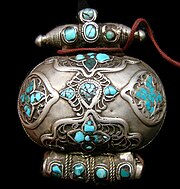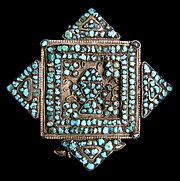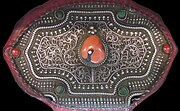Tibetan Gau
| Images of Tibetan Gaus: |
|---|

|

|

|

|

|
Tibetan Gaus (singular: the / the Tibetan Gau; Tib . : ga'u ) are mostly made of metal , small altar shrines, portable reliquary containers or small box-like objects for relics or amulets , which are attached to a chain on the neck or with a clasp on the hair attached.
Content of the Gaus

Gaus can contain a small statue of a Tibetan deity or a Buddha or similar representations as miniature paintings called "tsakli". The small statues can be made of metal, wood or stone be made or may be using molds from clay produced statuettes act, which in Tibetan Tsa-Tsa be mentioned. The latter can be consecrated by high lamas or the ashes of a deceased lama were added to the clay . In addition to these religious objects, relics such as bones , hair , fragments of the vestments of deceased religious teachers, religious texts or medicinal herbs can also be kept in Gaus . Also thokcha (Tib .: thog lcags ) called metal amulets may belong to the content of Gaus.
Forms of Gauss
Gauss usually consist of two parts and can be put together like a can . The front side is usually made of chased copper , silver or gold sheet and can also be decorated with gemstones such as corals and turquoise or pearls . It usually bears representations of Buddhas, deities or Buddhist symbols of good fortune and, in larger Gauss, has a window-like recess in the middle. The back side is mostly made of copper and can have engravings depicting inscriptions or religious symbols. Larger Gauss are rectangular and are usually arched in the upper part, while smaller Gauss, which are worn on a chain like a piece of jewelry or fastened in the hair with a clip, are square, polygonal or round.
Use of Gauss
Larger, non-portable Gaus can be found on the house altar . Portable gauss are worn over the shoulder with a fabric or leather strap so that they hang on the side or back of the body. This way of wearing Gauss is especially common on pilgrimages . Even nomads usually have a portable Gau who can find space on the tent altar. Small gauss can be worn constantly on the neck or in the hair; if they are made of valuable materials, they are put on for holidays .
Distribution area
In addition to Tibet , Gauss are also used in neighboring areas in which Tibetan culture is predominant: in Bhutan , Ladakh , northern Nepal , Lahaul and Spiti . In Ladakh, small Gauss are sewn onto the women's hoods called "Perak", together with turquoise and other gemstones.
literature
- Lee-Kalisch, Jeong-hee: Tibet monasteries open their treasure chambers . Ruhr Essen Cultural Foundation, Villa Hügel. Essen 2006. ISBN 978-3-7774-3115-4 .
- Richtsfeld, Bruno: The amulet container (Ga'u) and its contents . In: Claudius C. Müller and Walter Raunig: The way to the roof of the world , Pinguin-Verlag, Innsbruck, 1982. ISBN 3-7016-2119-5 , pp. 288-308.
- Waddell, Austine L .: The Buddhism of Tibet or Lamaism . Emphasis. Manjushri Publishing House, New Delhi, 1978 (first published in 1895).
- Weihreter, Hans: jewelry from the Himalayas . Academic printing and Publishing house, Graz, 1988. ISBN 3-201-01388-9 .
Individual evidence
- ↑ Weihreter, Hans: jewelry from the Himalayas . Academic printing and Verlagsanstalt, Graz 1988, ISBN 3-201-01388-9 , p. 103 .
- ↑ Lee-Kalisch, Jeong-hee: Tibet monasteries open their treasure chambers. Ruhr Essen Cultural Foundation, Villa Hügel. Essen 2006, pp. 477-481
- ↑ Weihreter, Hans: jewelry from the Himalayas. Academic printing and Verlagsanstalt, Graz, 1988. ISBN 3-201-01388-9 , p. 102
Web links
- " Gau: Tibetan Buddhist Prayer Box " . www.luckymojo.com; about Tibetan Gaus (English)